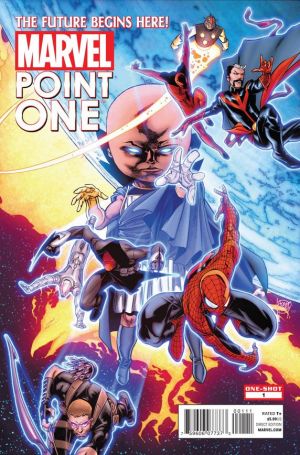Comics /
Comic Reviews /
Marvel Comics
Marvel Point One
By Zak Edwards
November 10, 2011 - 11:57
In light of recent discussions here at the Bin on the quality of Marvel Comics, I thought I would see what was going on in the aftermath of a couple of big events that I didn’t read. It turns out, despite my love of many Marvel Comics characters, I don’t really read any of their main universe work after dropping Thunderbolts a couple of months ago because I realized how little I cared about it. So this, coupled with my comic store’s practically giving it away price, I decided to read Marvel Point One. The comic promises to, like all the other point one issues, catch me up to speed on what’s going on and set in motion future events, a sort of lesson in context. And, like complaints about many of these point ones, this issue fails to be anything more than an overpriced advertisement.
In theory, these point ones are the greatest comic idea since the Ultimate Universe (though the crown has since shifted to the DC Reboot) and I’m happy they exist, even if I haven’t bought a single one. They are supposed to be jumping on points that actually serve as numerically independent stories, something curious readers can pick up without having to read the solicits for every issue of a comic. Gone, in theory, are the days of perusing Google with the search of “jumping on point for ______” and getting something that really isn’t. Unfortunately, this, the supposed mother of all point ones, except maybe the point two, point three, and point a million of the aftermath of Fear Itself, was supposed to get me up to speed.
 |
It didn’t. In any capacity.
Why? Because there is no history, just introductions to five new series told with a flimsy framing device. This is, and make no mistake, an advertisement anthology and, as such, is spotty in quality and frustrating in content. And the worst part, it leaves me more confused than anything else. For example, David Lapham’s story promoting his Age of Apocalypse series stars a man named Krakken. Perfect. Krakken: big black guy who kind of looks like Ultimate Nick Fury with the patch on the wrong eye. Wait, I don’t know who that is or why he’s getting attacked by William Stryker, whom I only know because I used to read Chris Yost and Craig Kyle’s New X-Men, and their X-Force series before it became a crossover book that made no sense on its own. The story assumes a continuity I don’t know that makes it difficult to follow and, in my extremely humble opinion, completely against the point of the book. Jeph Loeb’s Harbringer is a little better. Still in media res, as it were, but at least it sets something up for future reading, but still doesn’t answer any questions about what exactly was going on. Oh, and the fact the whole thing comes off as a Green Lantern Corps. clone, complete with Darkseid-looking villain and something called the Nova Corps. doesn’t really sell me on it. I’d rather read Green Lantern if I had any semblance of interest, which I don’t. Easily the
 |
best story for what this book wants to accomplish is Chris Yost’s Scarlet Spider story, that references past events, explains them succinctly, and offers an entire story that sets up another book. The other stories are fairly throwaway that all suffer from presuppositions. “Yin & Yang” offers up another story for the Avengers while not catching up anything to speed (Captain America screaming a mission statement hardly counts as history), while Bendis’ explosion-filled story doesn’t really say anything, despite plenty of speech balloons. Overall, I thought this book was going to offer me a way into stories I want to read, an opportunity to jump on after I left for better pastures, but all it does is make things seem even more difficult to figure out.
The artwork, however, is almost universally good. From the classic Kirby-esque work of Javier Pulido to the rougher beauty of Roberto de la Torre (my favourite of the book) and the familiarity of Bryan Hitch and Salvador Larroca, the book looks better than what it sounds like. Opening with Pulido in a story about the Watcher is an obviously good choice, tapping readers into Marvel Comics heyday in the sixties visually before presenting much more contemporary art, it brings a historicity to a book that otherwise doesn’t offer any. I simply adored de la Torre’s work, it’s roughness and heavy inking was moody and gritty in all the right ways. Old veterans and popular artists certainly put their best in as well, it’s all quite nice to look at and I even appreciated Hitch’s full page of shakiness, making the page almost reflect a sort of reality cam/ Children of Men aesthetic. While the book can’t survive on its own (even though this could be a decent contender), this point one is nice to look at. If only there wasn’t all those balloons in the way.
Grade: C Betraying the point while looking really good doing it.
Last Updated: January 17, 2025 - 08:20

